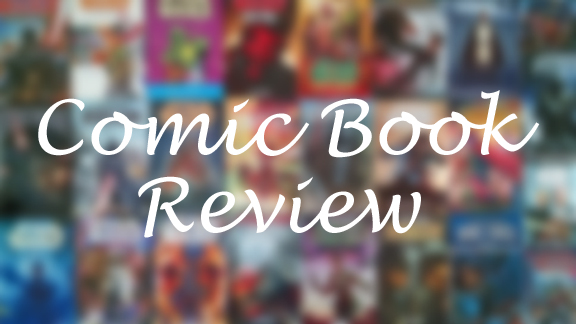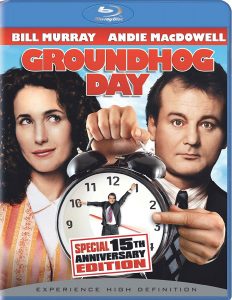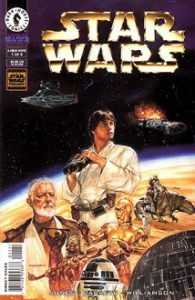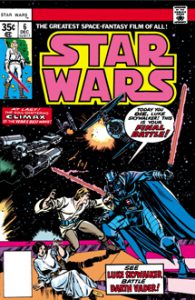“Star Wars’ ” comic book history naturally started with “Episode IV: A New Hope” (1977), and the adaptation by writer Roy Thomas and artist Howard Chaykin is still a fun read today for its vibrant energy. Plus, it gains serious kitsch value for its odd departures from what we now understand to be the Galaxy Far, Far Away.
Getting to know the GFFA
Thomas and Chaykin were getting to know “Star Wars” at the same time as everyone else. While they were bumped from the Marvel comics after Issue 10 in part because George Lucas didn’t like their work, their six-issue “A New Hope” adaptation is still widely loved for both quality and nostalgia.
Thomas and Chaykin get the spirit of the film right, but not with a straight copying of the script. Especially when introducing each issue, Thomas comments as if he’s an outside observer. At the start of Issue 4, right after our heroes free Princess Leia, Thomas tells the reader: “We’re kind of in a hurry, so pay attention …”

“Star Wars” comic adaptation (1977)
Writer: Roy Thomas
Pencils: Howard Chaykin
Inks: Howard Chaykin, Steve Leialoha, Rick Hoberg, Bill Wray
Colors: Pamela Rambo
When Luke and Han “accidentally” let Chewbacca loose and pretend to shoot at him, Thomas notes that “their enthusiasm (was) undeniable, their aim execrable.” The creative team captures the mysterious element of those early days of getting to know “Star Wars” when Chaykin zeroes in on a TIE fighter pilot and Thomas waxes: “Within the short-range starships of the Empire, air-giving helmets hide all life, all emotion.”
These are prime example of how Thomas complements Chaykin’s action-packed art with well-chosen words. Additionally, Thomas adds dialog for the sake of explanation, and the extra words enjoyably bring the dime-store flavor to the surface. For example: “This control box will pop you out into the open!” and “Touch the brightly colored button up there by the pommel.”
They get many details about Lucas’ vision “wrong” – most of which I don’t blame them for, because how could they know? I see these incorrect elements as features rather than bugs. I have no need to watch “A New Hope” ever again (due to overfamiliarity), but I enjoyed re-reading this comic because it’s a different enough take on the material to be fascinating.
Thomas puts his spin on it
Thomas invents his own “Star Warsian” words and phrases (solar fin, grappling rays, repair pod, technico) that didn’t catch on; however, the idea of having GFFA-specific words and phrases would endure throughout the Expanded Universe era. (When Disney took over, it switched to mostly Earth-based words.)
Sometimes he uses the wrong term, such as starfighter instead of blockade runner, a reminder that before “Star Wars” codified it, “starfighter” was a vague term, rather than meaning a small, one-man craft.
It’s apparent that – as with most comic adaptations – the creators weren’t working from the finalized script and stills. The script differences are mostly trivial, such as the ID of the stormtrooper posted outside the Falcon and the number of the trash compactor. (The fact that Lucas waffled on minor details is an early indication of a slightly autistic perfectionist streak that manifested 20 years later with the Special Editions.)

Other alterations have good reasons, such as Blue Group becoming Red Group because blue stripes became invisible in the blue-screen process. Oddly, the colorists (several are credited throughout the series) know to give the X-wings red stripes but the dialog maintains the “Blue” designations.
Some things are drawn or colored differently, including Tarkin (Chaykin can’t quite nail Peter Cushing’s likeness), Ponda Baba, Garindan, Jabba the Hutt (here he’s the Nimbanel who would be reimagined as Mosep Binneed), the torture droid (it’s bipedal), a spaceship flying around the Death Star (it looks like the Star Tours ship), the Millennium Falcon’s cockpit (it’s too roomy), the portrayal of lightspeed (a sequence of colored bars), the Death Star’s color (white, like a space Technodrome) and Ben Kenobi’s demise (he seems to melt at the point of Vader’s lightsaber more so than vanish).
Hints of earlier drafts
This adaptation gives hints of what Lucas was refining till the last moment, as several not-quite-right character and story traits make it into the comic. In her message, Leia calls Obi-Wan a commander, rather than a general. Darth Vader holds a beverage in the conference room, as if he can drink through his respirator.
Later known as Jek Porkins, the portly pilot is called Lieutenant Tono Porkins here, and nicknamed “Piggy.” (The retcon is that his full name is Jek Tono Porkins.) The Rebel Alliance celebration includes banners of planets loyal the Rebellion; more accurately, this rebellion happened covertly – there was no outright secession.
Vader is subservient to Tarkin, calling him “sir”; by the time of the finished film, Vader and Tarkin are equals, each with his own area of expertise, for which they show mutual respect. Obi-Wan talks about himself during the lightsaber duel, noting that he “has grown much since our parting.”
While the point is accurate, it’s out of character for him to give away the truth (when he does reveal something, it’s a half-truth at best). In the finished film, he focuses on Vader’s failings, such as being “only a master of evil.”
Although not as interesting today, as the deleted scenes were made available on the 2011 Blu-ray, the 1977 comic adaptation features the Biggs scenes, plus Red Leader (Blue Leader in the comic) recognizing Luke’s last name because he had met his father. And of course the Jabba scene (albeit with Binneed) was a deleted scene until the 1997 Special Edition.
Fun add-ons
I don’t know if these are early movie draft elements or Thomas’ embellishments, but here are three fun moments: When the group gets out of the trash compactor and Han shoots back at the dianoga, we see the creature’s tentacle in the frame. When the X-wing technician says “We’re about ready, Skyboy,” it makes me think of Ahsoka calling Anakin “Skyguy” in “The Clone Wars.”
And while Chewbacca doesn’t get a medal in the ceremony, Thomas notes that he’ll get one later: “He’ll have to put it on himself. Few space-princesses are THAT tall.”
The sometimes insane cover embellishments (the 1970s comic equivalent of today’s clickbait headlines) also qualify as alterations of sorts, allowing a reader to think about storytelling paths not taken. Issue 1 asks “Will Luke Skywalker save the galaxy or destroy it?,” as the cover designer dips his toes into the notion that there’s a fine line between the light and dark sides of the Force. Indeed, that would be an appropriate teaser for “Dark Empire.”
Issue 2’s cover features an all-out brawl in the cantina, Issue 4 imagines Luke trying to help Obi-Wan fight Darth Vader, Issue 5 finds the Death Star attacking the Yavin base with a volley of smaller beams rather than the planet destroyer, and Issue 6 teases a Luke-Vader lightsaber duel (something that Marvel would get to just before “The Empire Strikes Back”).

A new adaptation
For the 20th anniversary, and to tie in with the Special Edition movie release, Dark Horse understandably wanted to do a new adaptation in 1997. The plan was to tap Al Williamson, who penciled Marvel’s “Empire Strikes Back” and “Return of the Jedi” adaptations in the 1980s, so he could complete his trilogy.
Interestingly, he started an “A New Hope” adaptation for the newspaper strip back in the day before taking another gig. But a Williamson trilogy stayed tantalizingly out of reach, as he couldn’t commit to the Special Edition either (he did end up sharing inking duties with two others, so he did work on adaptations of all three films, but only technically).

“Star Wars: A New Hope” Special Edition adaptation (1997)
Writer: Bruce Jones
Pencils: Eduardo Barreto
Inks: Eduardo Barreto, Al Williamson, Carlos Garzón
Colors: James Sinclair, Cary Porter
There’s not much else to say about Dark Horse’s “Special Edition” adaptation. It’s 96 pages across four issues, which is only eight pages shorter than the Marvel version, but it can be read much faster because writer Bruce Jones and penciler Eduardo Barreto adapt the shooting script straight-up. Jones cuts many lines of dialog; by editing for space, he unfortunately removes the flow.
Not so special
The Jabba scene is in there, as are Greedo shooting first and the ronto and ASP droid shenanigans on the Mos Eisley streets. But the scene with Biggs, Luke and Red Leader in the Massassi hangar is missing, reflecting the fact that Lucas decided to re-install that scene later in the process. He never entertained the idea of including the Tatooine Biggs scenes in the Special Edition, despite clamor from fans.
As such, in terms of bonus scenes and unusual insights into the material, the original version – which was dramatically recolored by Marvel in 2015 — is more of a “special edition” than the actual Special Edition.
For a serious “Star Wars” fan, it’s easily the more entertaining and nostalgic reading experience. The 1997 version isn’t all that great for newcomers, because it rushes through the story so fast that lines of dialog have to be cut. An ideal adaptation would be somewhere between the two extremes; perhaps the manga edition (which I haven’t read yet) fits the bill.

